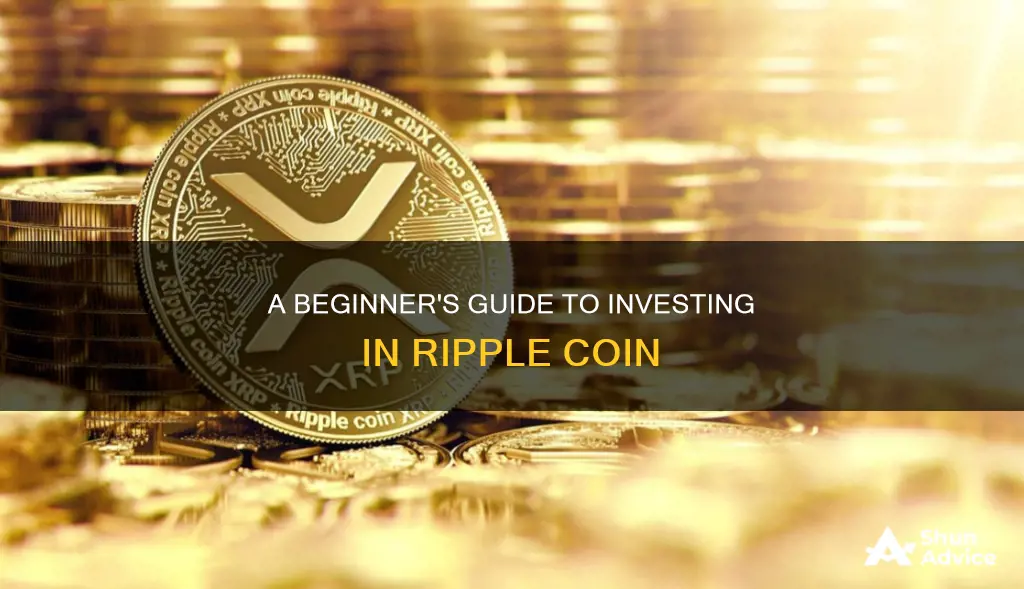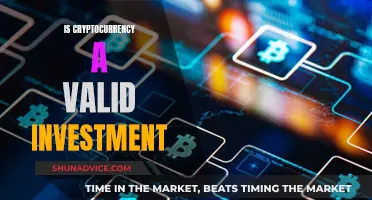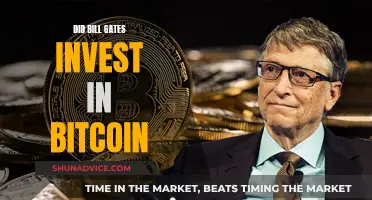
Ripple (XRP) is a cryptocurrency that runs on a network owned by a company called Ripple. It is designed to enable a frictionless way to send money globally. XRP is the native crypto token of the Ripple network and is currently the sixth most popular cryptocurrency. It can be bought on most crypto exchanges.
XRP is different from regular money because it is not controlled by any government or bank. Instead, it is created and managed by Ripple Labs, a private, for-profit company.
XRP has several advantages over the SWIFT system, which is currently used for international payments. It offers faster transactions, lower costs, greater transparency, and higher scalability.
However, investing in cryptocurrency is a high-risk venture. It is important to do your research and choose a reputable exchange before investing in XRP.
| Characteristics | Values |
|---|---|
| Type of Cryptocurrency | XRP is a cryptocurrency that can be used as a payment method or as a way to speculate on price movements. |
| Purpose | XRP can serve as a payment vehicle or as a speculative asset. |
| Buying Options | XRP can be bought via centralized crypto exchanges, peer-to-peer, or decentralized exchanges (DEXs). |
| Centralized Crypto Exchanges | Bitstamp, Kraken, Huobi Global, Coinbase, Uphold, Coinmama, Binance, eToro, Gemini, and more. |
| Decentralized Exchanges | DEXs facilitate crypto buying and selling without a third-party intermediary, relying on code and technology to carry out transactions. |
| Payment Methods | Fiat money (USD, EUR, JPY, etc.), payment cards, or other crypto assets. |
| Wallet Options | Hot or cold wallets, hardware wallets (e.g. Ledger), software wallets, cloud wallets, and mobile wallets. |
| Transaction Speed | XRP can settle payments in 3 to 5 seconds. |
| Transaction Cost | XRP has a very low transaction fee of 0.0001 XRP. |
| Regulation | XRP has faced regulatory challenges, particularly with the U.S. Securities and Exchange Commission (SEC). |
| Risk | XRP is a high-risk investment due to its volatility and regulatory issues. |
What You'll Learn

Choosing a platform
XRP is available on a wide range of platforms, including centralized and decentralized exchanges, peer-to-peer services, and mobile wallets. Here are some factors to consider when choosing a platform:
Security: The safety of your funds should be a top priority when selecting a platform. Look for exchanges that have a strong track record of security measures, such as Kraken, which is known for its state-of-the-art technology and procedures that protect client funds.
Regulation: It is important to choose a regulated exchange to lower the risk of losing money. Make sure the platform complies with the laws and regulations of your jurisdiction.
Payment Methods: Different platforms offer different payment methods for purchasing XRP. Some common options include bank transfers, credit or debit cards, and payment in other cryptocurrencies. Choose a platform that supports your preferred payment method.
Fees: Each platform will charge different fees for buying, selling, and trading XRP. Compare the fees across platforms to find the most cost-effective option for your needs.
Liquidity: Opt for platforms with higher trading volumes and liquidity, as they will generally provide better prices and faster transaction execution.
User Interface: Consider choosing a platform with a user-friendly interface, especially if you are a beginner. A simple and intuitive platform will make it easier to navigate the buying process.
Customer Support: Look for a platform that offers reliable customer support in case you encounter any issues during the buying process or with your account. 24/7 customer support is ideal.
Geographic Availability: Not all platforms are available in every country or region. Ensure that the platform you choose supports users from your geographic location.
When choosing a platform, it is essential to conduct your own due diligence and read reviews from other users. Additionally, keep in mind that the availability of certain platforms and payment methods may vary depending on your location.
Dimcoin Investment: A Beginner's Guide to Getting Started
You may want to see also

Payment methods
XRP can be purchased from centralized cryptocurrency exchanges, peer-to-peer (P2P) services, decentralized finance (DeFi) platforms, cryptocurrency ATMs, payment processors, and mobile wallets. You can also earn XRP through certain exchange reward programs.
Centralized exchanges like Bitstamp, Kraken, Huobi Global, and Coinbase offer a wide selection of trading features and digital currencies, including XRP. These exchanges typically require users to set up an account with login details and provide certain personal information, such as location and name. Some exchanges also ban customers from specific geographic regions. It is important to research and comply with the laws and regulations that apply to your jurisdiction.
When buying XRP on a centralized exchange, you can send fiat money (USD, EUR, JPY, etc.) via bank transfer or use a payment card to purchase the digital asset directly. Depending on the exchange, you may also be able to pay for XRP with other crypto assets, such as Bitcoin or Ethereum, through crypto-to-crypto pairings.
Decentralized exchanges (DEXs) have also become a popular option for buying XRP. DEXs facilitate crypto buying and selling without a third-party intermediary, relying solely on code and technology to execute transactions. However, DEXs typically function on a main blockchain, limiting the assets they can trade to those built on their native blockchain.
For those who prefer direct transactions, peer-to-peer (P2P) services offer the opportunity to buy XRP directly from another party. This can be done by meeting in person and conducting the transaction with cash, but it is important to exercise caution when dealing with strangers.
Another option for purchasing XRP is through cryptocurrency ATMs, which provide a convenient way to buy cryptocurrencies without the need for a traditional exchange account. Users can search for crypto ATMs that support XRP on websites like ATMlocator and CoinMap.
Lastly, mobile wallets allow users to buy XRP and store the keys on their phones, although the fees charged for mobile payments can be high.
The Ultimate Guide to Investing in Bitcoin
You may want to see also

Creating an account
- Choose a Platform: Select a cryptocurrency exchange or broker that offers XRP trading. Popular options include Uphold, Kraken, CoinJar, and Coinbase. Each platform will have its own features, fees, and requirements, so be sure to research and choose one that suits your needs.
- Sign Up: Visit the website of your chosen platform and look for the "Sign Up" or "Create Account" option. You will typically need to provide basic information such as your name, email address, and choose a secure password. Some platforms may also require additional information, such as your date of birth, country, and phone number.
- Verify Your Account: Most platforms will require you to verify your identity before you can start trading. This process may vary but generally involves providing documents such as a government-issued ID, proof of address, or a selfie for biometric verification. The verification process helps comply with regulatory requirements and ensures the security of your account.
- Set Up Security: After creating your account, it is important to enable additional security measures. Look for options such as two-factor authentication (2FA), where you will receive a unique code via SMS or an authentication app each time you log in. This adds an extra layer of security to your account.
- Fund Your Account: Once your account is verified, you will need to deposit funds into your account. This can be done by linking a bank account, using a credit or debit card, or even depositing other cryptocurrencies if you already own some. Different platforms may offer different funding options, so be sure to check their supported payment methods.
- Start Trading: After your account is funded, you can proceed to buy XRP. Look for the option to "Buy" or "Trade" XRP on the platform. You may have the option to place a market order, which executes immediately at the best available price, or a limit order, which allows you to specify the price you want to pay for XRP.
Remember to do your research before choosing a platform and investing in XRP. Each platform will have its own unique features, fees, and security measures, so it's important to understand the pros and cons of each before creating an account. Additionally, always ensure that you have a secure internet connection and device when creating your account to protect your personal and financial information.
Borrowing to Buy Bitcoin: A Risky Investment Strategy?
You may want to see also

Buying and storing XRP
Buying XRP
There are several ways to buy XRP, a cryptocurrency that acts as a bridge to facilitate the transfer of value and make money transfers between traditional financial institutions faster and cheaper.
XRP can be purchased on crypto exchanges such as Bitstamp, Kraken, Huobi Global, and Coinbase. These exchanges allow you to buy XRP with fiat currencies like euros, pounds, or dollars. You can use a credit/debit card or bank transfer directly on the exchange. To buy XRP on these exchanges, you'll first need to create and validate your account by providing some personal information. Once approved by the exchange, you can start buying XRP.
XRP can also be purchased from centralized cryptocurrency exchanges, peer-to-peer (P2P) services, decentralized finance (DeFi) platforms, cryptocurrency ATMs, and payment processors.
Additionally, you can earn XRP rewards by participating in certain earnings programs sponsored by exchanges, such as lending, liquidity provision, and rewards programs.
Storing XRP
After buying XRP, you'll need a safe place to store it. There are several options for storing your XRP:
- Hardware Wallets: These are physical devices that store the private keys to your assets, allowing you to interact with your wallet without exposing your data. Ledger, Keystone, and Trezor are examples of hardware wallets that support XRP.
- Paper Wallets: This method involves printing your private keys and recovery passphrases on a piece of paper and storing it for safekeeping. However, this approach is considered clunky and more vulnerable to phishing scams.
- Software Wallets: These are "hot" wallets that can be downloaded to store your crypto assets. There are desktop and mobile wallet options. Trust Wallet is an example of a mobile wallet that supports XRP.
- Crypto Exchanges: Some exchanges that trade XRP, such as Coinsmart, Crypto.com, and Binance, also allow you to store your crypto on their platforms.
Bitcoin: A Long-Term Investment Worth Your Money
You may want to see also

Risks and regulations
As with any investment, there are risks involved in investing in cryptocurrencies. Cryptocurrencies are highly volatile, meaning your cash can go down as well as up in no time at all. XRP is no exception to this. In fact, XRP has had a particularly turbulent history, slumping in 2019 and continuing to struggle throughout 2019 and 2020.
In 2020, the US Securities and Exchange Commission (SEC) filed a lawsuit against Ripple Labs Inc., alleging that the company had conducted an unregistered securities offering by selling XRP to investors. This led to some platforms, such as Coinbase, suspending or removing XRP trading to avoid potential regulatory issues. The case is ongoing, and investors are warned that ongoing litigation may lead to higher legal and regulatory risks associated with XRP. Crypto exchanges may suspend trading or end support for XRP due to developments in the litigation.
In addition, XRP may present concentration risk due to its initial distribution being split between its founders and Ripple Labs. XRP also faces challenges and risks in terms of regulation, competition, and security. In 2023, an executive of Ripple, Chris Larsen, had his private wallet hacked for a reported US$112.5 million in XRP, causing the price of XRP to fall.
The UK's Financial Conduct Authority (FCA) has also issued warnings about the risks of investing in cryptocurrencies, including the risk of losing all your money, price volatility, consumer protection issues, product complexity, charges and fees, and misleading marketing materials.
It is important to do your research and understand the risks before investing in XRP or any other cryptocurrency.
Lite Coin: Worthy Investment or Risky Business?
You may want to see also
Frequently asked questions
Ripple (XRP) is a cryptocurrency that operates on its own blockchain, the XRP Ledger (XRPL). It is designed to improve cross-border payments and can be used as a payment method or as a way to speculate on price movements.
You can buy XRP on several exchanges, such as Bitstamp, Kraken, Huobi Global, and Coinbase. You can also purchase it directly within some third-party wallets.
It's important to note that investing in cryptocurrency is a high-risk venture. XRP, in particular, has faced regulatory challenges and was delisted from some exchanges due to a legal dispute with the US Securities and Exchange Commission (SEC). Be sure to do your own research and understand the risks before investing.







